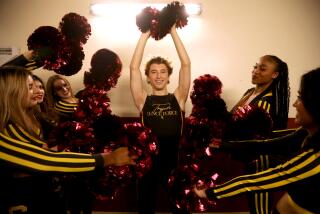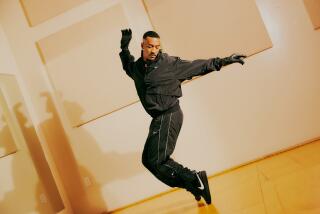In ‘Future,’ Curran’s Troupe Takes an Original Step
Irish music blares from loudspeakers at the Alex Theatre and suddenly the star dancer-choreographer of this Sunday performance appears--one arm bent with fist clenched, the other extended out and up in the signature, heroic “Lord of the Dance” stance.
But because this particular dancer-choreographer is the deliberately antiheroic Sean Curran, a man who’ll pause amid a flurry of steps to pant like a dog, his grandiose Michael Flatley pose gets laughs--and even more later in the same piece when he repeats it to attract Heather Waldon-Arnold, who remains unimpressed.
Curran studied Irish step dancing as a child in Boston and knows the vocabulary and style well enough to not only parody them but also turn them inside out technically. Set to recordings of unaccompanied traditional Irish vocals, his “Folk Dance for the Future” takes all the down-into-the-floor emphasis of “Riverdance” footwork and reverses it, making the 10 barefoot members of his company miraculously buoyant.
Wearing plaid kilts and either black tops (the women) or shirts and ties (the men), the dancers fly through circle and line formations, taking their fast, intricate steps up into the air at every opportunity. Waldon-Arnold, who also displayed pristine ballet technique in the program’s other three pieces, gets into the Celtic spirit with a solo full of eccentric limb contortions at breakneck speed.
Near the end, three couples bring in dolls representing their babies, posing for imaginary family photos and teaching the dolls to perform the steps we’ve been watching. Tony Guglietti and Eun Jung Gonzalez form one Mr. and Mrs., but the couples also include Peter Kalivas with Jeff Rebudal (Mr. and Mr.) and Marisa Demos with Donna Scro Gentile (Mrs. and Mrs.).
Same-sex pairings of this sort--the political points they make and the partnering challenges they offer--occur throughout the program. In “Metal Garden” they evolve from deft, playful group clusters--shoulders wagging, arms pumping, hands flung up--set to a jazz score by Tigger Benford and Peter Jones. Curran plays the outsider here, periodically wandering through carrying garden implements, including a fawn lawnsculpture. The rest of the cast pairs off for a series of happy duets, with Juan Carlos Claudio and Waldon-Arnold especially prominent.
In perhaps the most memorable sequence, the dancers in each couple take turns using their arms to form hoops through which their partners slowly step, crawl and glide in a potent formal metaphor for shifting patterns of intimacy.
More Benford percussion drives the breezy “Abstract Concrete,” though here the dancers continually form lines when they’re not swooping through circular reaching motifs accented with flung-out hands or robotic moves. Duets for Guglietti and Demos become major structural building blocks, but his remarkable torso articulation and her ability to lift a guy who looks twice her weight would make them standouts anywhere.
In “Symbolic Logic,” the lines become circles: a big, white open ring that designer Mark Randall places center stage, plus smaller colored discs on the back of the nine dancers’ white gym suits. Wheel formations also occur in the choreography, though here the style is curry-flavored, reflecting the accompaniment: vocals by Indiapop singer Sheila Chandra.
Not only do the dancers adopt stances, walks and hand signals (mudras) evoking classical Indian dance, but martial arts kicks and quasi-exotic semaphore as well. These components nearly always melt into focused if whimsical modernism as the choreography heats up for the finale: three layers of dancers moving with spectacular speed, force and clarity to chanted Indian rhythm syllables.
Curran’s reputation for original work is confirmed, but “Symbolic Logic” unites his backgrounds as a postmodern dancer (for Bill T. Jones and Arnie Zane) and a Broadway gypsy (in “Stomp!”) in one inspired, masterly showpiece.
More to Read
The biggest entertainment stories
Get our big stories about Hollywood, film, television, music, arts, culture and more right in your inbox as soon as they publish.
You may occasionally receive promotional content from the Los Angeles Times.










